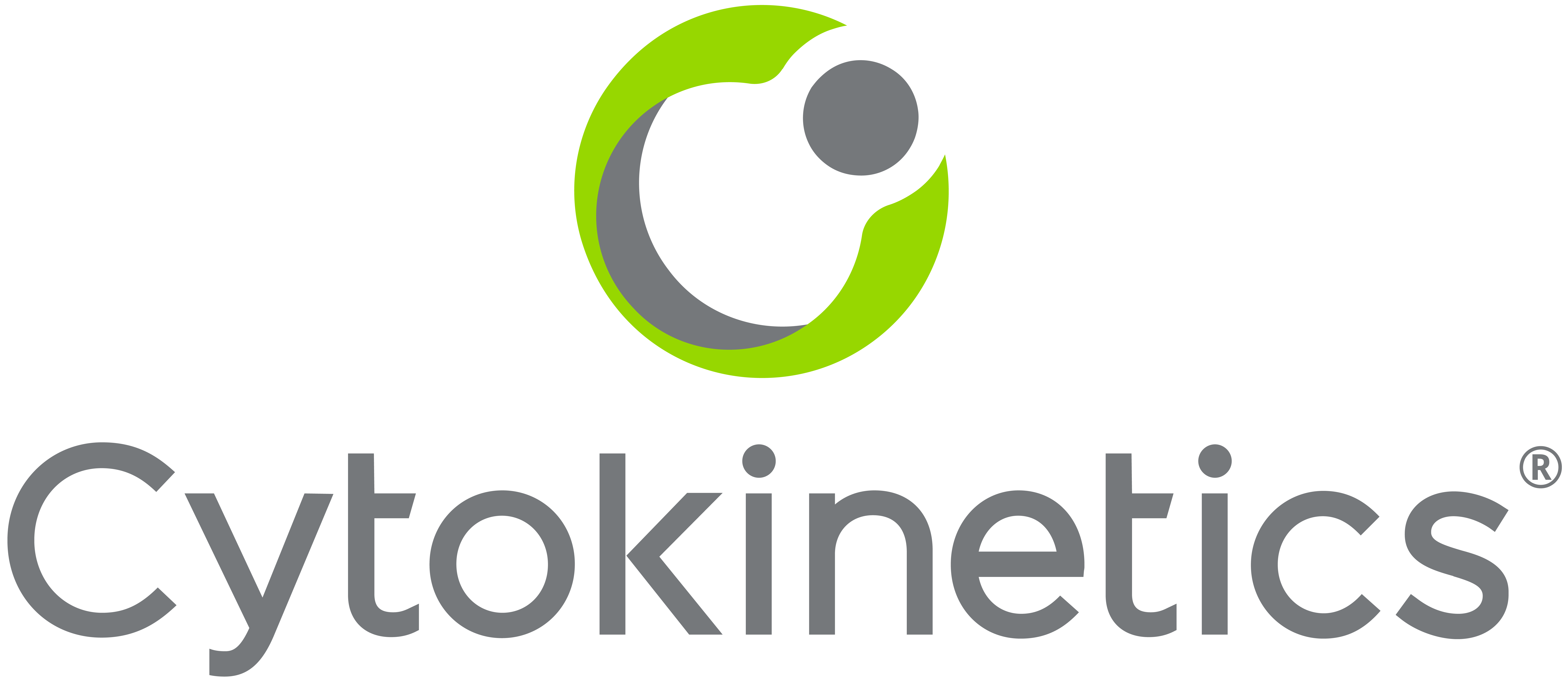Cytokinetics Announces Three Publications Relating to Tirasemtiv and the Impact of Skeletal Muscle Activation on Respiratory Function and Muscle Strength
Manuscripts Support Rationale for Potential Further Development of Tirasemtiv in Patients Living with ALS
South San Francisco, CA, May 21, 2014 - Cytokinetics, Incorporated (Nasdaq: CYTK) announced the recent publication of three peer-reviewed manuscripts relating to tirasemtiv and fast skeletal muscle troponin activation in the journals PLOS ONE, Muscle & Nerve, and the American Journal of Respiratory and Critical Care Medicine. These publications relate to pre-clinical and clinical studies conducted in support of the development of tirasemtiv. The reported data are consistent with results observed regarding certain measures of respiratory function and muscle strength in BENEFIT-ALS (Blinded Evaluation of Neuromuscular Effects and Functional Improvement with Tirasemtiv in ALS) in patients with amyotrophic lateral sclerosis (ALS). BENEFIT-ALS is the first large Phase II clinical trial in patients with ALS to show a statistically significant reduction in the decline of a clinically relevant measure of respiratory function, slow vital capacity, and of a measure of muscle strength.
"We are pleased to share additional scientific and clinical trial data that elaborate on the mechanistic effects of tirasemtiv and related compounds on muscle that we believe translate to demonstrable effects on certain measures of respiratory function and muscle strength," stated Fady I. Malik, MD, PhD, Cytokinetics' Senior Vice President, Research and Early Development. "We believe the results of these studies support the rationale for further developing tirasemtiv in patients with ALS."
Summary of Published Manuscripts
The first publication, titled "Fast Skeletal Muscle Troponin Activator Tirasemtiv Increases Muscle Function and Performance in the B6SJL-SOD1G93A ALS Mouse Model," appeared in the May 7, 2014 edition of PLOS ONE. The objective of the study was to examine the effects of tirasemtiv in a transgenic mouse model of ALS that expresses the mutant human superoxide dismutase 1 (SOD1) gene responsible for an inherited form of ALS. The B6SJL-SOD1G93A mouse develops progressive limb and body weakness eventually culminating in full limb paralysis, morbidity and death at about 135-140 days of life. The authors evaluated the effect of single doses of tirasemtiv on several measures of skeletal muscle function and fatigability and of respiratory performance. The authors concluded that a single dose of tirasemtiv significantly increased submaximal isometric muscle force in the mouse leg, forelimb grip strength, grid hang time, and the performance while running/climbing on a rotating drum in mice that had developed substantial weakness due to their disease progression. Additionally, tirasemtiv significantly increased the force generation of isolated diaphragm muscle and of tidal volume, a measure of how much air the mice exhale with each breath. These effects of tirasemtiv on measures of respiratory function in a mouse model of ALS are consistent with the observed effects of tirasemtiv on certain measures of respiratory function in patients with ALS.
The second publication, titled "Tirasemtiv Amplifies Skeletal Muscle Response to Nerve Activation in Humans," appeared on March 13, 2014 as an on-line publication in the journal Muscle & Nerve. This paper describes findings from the Phase I first-time-in human clinical trial of tirasemtiv which was designed to assess the maximum tolerated dose (MTD) and the pharmacodynamic effects of tirasemtiv on skeletal muscle function in healthy volunteers. After completing the dose escalation phase and determining the MTD, the study tested the hypothesis that tirasemtiv could amplify the response of muscle to neuromuscular input in humans. Doses of tirasemtiv (250, 500, and 1000 mg dosed orally) and placebo were administered in a randomized, double-blind, 4-way crossover design to twelve healthy male subjects; each dosing period was separated by at least a week. The deep fibular nerve was stimulated transcutaneously at frequencies from 5 to 50 Hertz to activate the tibialis anterior muscle and produce dorsiflexion of the foot. In this clinical trial, tirasemtiv increased force produced by the tibialis anterior muscle in a dose-, concentration-, and frequency-dependent manner with the largest increases produced at sub-tetanic nerve stimulation frequencies. At plasma concentrations of tirasemtiv exceeding 12 µg/mL, the maximum placebo-corrected least-square mean percent increase from baseline in peak muscle force was 24.5% ± 3.1 (mean ± standard error, p < 0.0001) at a stimulation frequency of 10 Hertz. These Phase I clinical trial data support translation of the novel mechanism of action for tirasemtiv from preclinical models to humans.
The third publication, titled "Diaphragm Fiber Strength is Reduced in Critically Ill Patients and Restored by a Troponin Activator," appeared in the April 2, 2014 edition of the American Journal of Respiratory and Critical Care Medicine. The objective of the study was to understand whether contractile weakness of diaphragm muscle fibers develops in mechanically ventilated critically ill patients and whether fast skeletal troponin activation by a structural analog of tirasemtiv, CK-2066260, could improve its contractile strength. The authors obtained diaphragm biopsy samples from mechanically ventilated critically ill patients who were undergoing laparotomy or thoracotomy. Similar samples from patients undergoing elective lung surgery served as controls. The critically ill patients were mechanically ventilated for an average of 210 hours compared to only 1.6 hours for the control patients. The studies indicated that muscle fibers from the critically ill patients were atrophied (smaller) and also that the maximal contractile strength was substantially lower (weaker) than muscle fibers from the control patients. The authors tested the effect of the fast skeletal troponin activator, CK-2066260, on diaphragm muscle fiber strength. The authors concluded that CK-2066260 increased the muscle fiber response to calcium such that the force produced by the diaphragm fibers from critically ill, mechanically ventilated patients was restored to the level of force produced by the diaphragm fibers from control patients at physiological calcium concentrations. These effects of CK-2066260 support the therapeutic hypothesis for tirasemtiv to potentially increase measures of pulmonary function in humans.
About Tirasemtiv and BENEFIT-ALS
Tirasemtiv, a novel skeletal muscle activator, is the lead drug candidate from Cytokinetics' skeletal muscle contractility program. Tirasemtiv selectively activates the fast skeletal muscle troponin complex by increasing its sensitivity to calcium and, in preclinical studies, demonstrated increases in skeletal muscle force in response to neuronal input and delays in the onset and reductions in the degree of muscle fatigue. BENEFIT-ALS was a Phase IIb, multinational, double-blind, randomized, placebo-controlled clinical trial designed to evaluate the safety, tolerability and potential efficacy of tirasemtiv in patients with amyotrophic lateral sclerosis (ALS). BENEFIT-ALS did not achieve its primary efficacy endpoint, the mean change from baseline in the ALS Functional Rating Scale in its revised form (ALSFRS-R). Treatment with tirasemtiv resulted in a statistically significant and potentially clinically meaningful reduction in the decline of Slow Vital Capacity (SVC), a measure of the strength of the skeletal muscles responsible for breathing that has been shown to be an important predictor of disease progression and survival in prior trials of patients with ALS. The analyses of other pre-specified secondary efficacy endpoints produced mixed results. Results from BENEFIT-ALS were presented at the 66th Annual Meeting of the American Academy of Neurology on April 29, 2014. Cytokinetics expects to continue to analyze the data from BENEFIT-ALS to inform the potential further development of tirasemtiv in patients living with ALS.
About Cytokinetics
Cytokinetics is a clinical-stage biopharmaceutical company focused on the discovery and development of novel small molecule therapeutics that modulate muscle function for the potential treatment of serious diseases and medical conditions. Cytokinetics' lead drug candidate from its cardiac muscle contractility program, omecamtiv mecarbil, is in Phase II clinical development for the potential treatment of heart failure. Amgen Inc. holds an exclusive license worldwide to develop and commercialize omecamtiv mecarbil and related compounds, subject to Cytokinetics' specified development and commercialization participation rights. Cytokinetics is independently developing tirasemtiv, a fast skeletal muscle activator, as a potential treatment for diseases and medical conditions associated with neuromuscular dysfunction. Tirasemtiv is the subject of a Phase II clinical trials program and has been granted orphan drug designation and fast track status by the U.S. Food and Drug Administration and orphan medicinal product designation by the European Medicines Agency for the potential treatment of amyotrophic lateral sclerosis (ALS). Cytokinetics is collaborating with Astellas Pharma Inc. to develop CK-2127107, a skeletal muscle activator structurally distinct from tirasemtiv, for non-neuromuscular indications. All of these drug candidates have arisen from Cytokinetics' muscle biology focused research activities and are directed towards the cytoskeleton. The cytoskeleton is a complex biological infrastructure that plays a fundamental role within every human cell. Additional information about Cytokinetics can be obtained at www.cytokinetics.com.
This press release contains forward-looking statements for purposes of the Private Securities Litigation Reform Act of 1995 (the "Act"). Cytokinetics disclaims any intent or obligation to update these forward-looking statements, and claims the protection of the Act's Safe Harbor for forward-looking statements. Examples of such statements include, but are not limited to, statements relating to Cytokinetics' research and development activities, including the potential significance and utility of the results from preclinical studies and clinical trials of tirasemtiv; planned further analyses of the results from BENEFIT-ALS and the potential outcomes of such analyses; potential further development of tirasemtiv; and the properties and potential benefits of skeletal muscle activators and of tirasemtiv and Cytokinetics' other drug candidates. Such statements are based on management's current expectations, but actual results may differ materially due to various risks and uncertainties, including, but not limited to, the results of BENEFIT-ALS may not support further clinical development of tirasemtiv; further clinical development of tirasemtiv in ALS patients, if supported by the BENEFIT-ALS data, will require significant additional funding, and Cytokinetics may be unable to obtain such additional funding on acceptable terms, if at all; potential difficulties or delays in the development, testing, regulatory approvals for trial commencement, progression or product sale or manufacturing, or production of Cytokinetics' drug candidates that could slow or prevent clinical development or product approval, including risks that current and past results of clinical trials or preclinical studies may not be indicative of future clinical trials results, patient enrollment for or conduct of clinical trials may be difficult or delayed, Cytokinetics' drug candidates may have adverse side effects or inadequate therapeutic efficacy, the U.S. Food and Drug Administration or foreign regulatory agencies may delay or limit Cytokinetics' or its partners' ability to conduct clinical trials, and Cytokinetics may be unable to obtain or maintain patent or trade secret protection for its intellectual property; Amgen's and Astellas' decisions with respect to the design, initiation, conduct, timing and continuation of development activities for omecamtiv mecarbil and CK-2127107, respectively; Cytokinetics may incur unanticipated research and development and other costs or be unable to obtain additional financing necessary to conduct development of its products; Cytokinetics may be unable to enter into future collaboration agreements for its drug candidates and programs on acceptable terms, if at all; standards of care may change, rendering Cytokinetics' drug candidates obsolete; competitive products or alternative therapies may be developed by others for the treatment of indications Cytokinetics' drug candidates and potential drug candidates may target; and risks and uncertainties relating to the timing and receipt of payments from its partners, including milestones and royalties on future potential product sales under Cytokinetics' collaboration agreements with such partners. For further information regarding these and other risks related to Cytokinetics' business, investors should consult Cytokinetics' filings with the Securities and Exchange Commission.
Contact:
Cytokinetics, Inc.
Joanna L. Goldstein (Investors & Media)
(650) 624-3000



